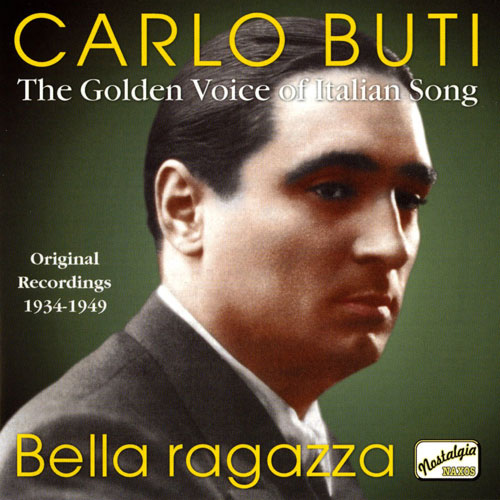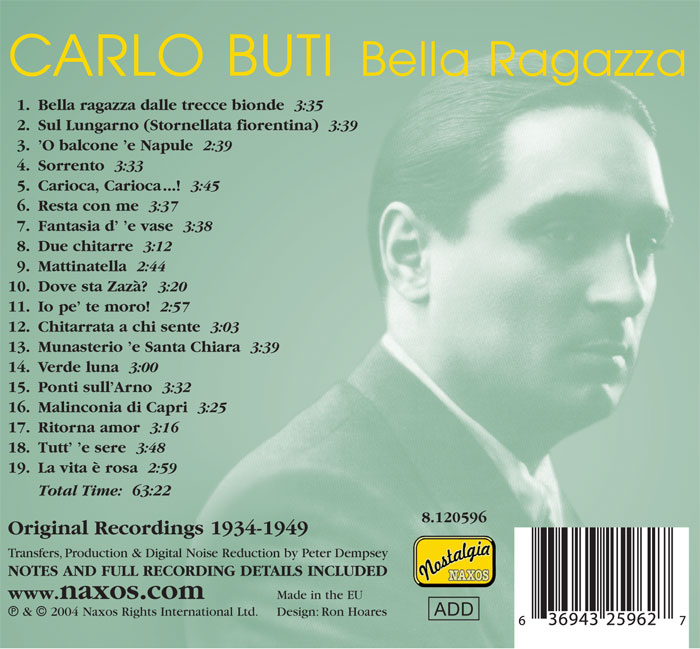Logowanie
Mikołaj - ten to ma gest!
Miles Davis, Horace Silver, Jay Jay Johnson, Percy Heath, Kenny Clarke, Lucky Thompson
Walkin'
20bit K2Super Coding - ale jak to brzmi!
Kasety magnetofonowe
Winylowy niezbędnik
ClearAudio
Double Matrix Professional - Sonic
najbardziej inteligentna i skuteczna pralka do płyt winylowych wszelkiego typu - całkowicie automatyczna
Carlo Buti
Bella Ragazza (1934-1949)

- Carlo Buti - vocal
Original 1934-1949 Recordings
"A stalwart of pioneering Italian radio and a master of microphone technique, between the World Wars Carlo Buti became a virtual synonym for the canzone di genere leggero. All the latest love-songs, however clichéd, were ‘Buti-fied’ and within the confines of a highly individual if rather limited voice this stylist who won the admiration of Beniamino Gigli, Galliano Masini and Tito Schipa became a role-model to a younger generation headed by Luciano Virgili and Claudio Villa. His phonically ingratiating half-tones made Buti a gift to the popular record industry of which, by 1935, he was a leading light. Prolific, he turned down little or nothing that was offered him, however trite, and in him tenor and crooner commingled as, via the air-waves and scores of internationally distributed recordings, he made the new Italian brand of cabaret initiated by Meme Bianchi, Daniele Serra, Gennaro Pasquariello and others accessible to a wider audience. Polished and distinctive, in his sphere Buti had few peers (the Sicilian Luciano Tajoli among the few, and a later arrival) and in his own way he was unique, the sort of artistic phenomenon which could only have come to light in the early days of radio and commercial recording and, with the artistic climate of the Fascist ventennio in mind, perhaps nowhere else but in Italy. Carlo Giuseppe Eugenio Buti was born in San Frediano (Oltrarno), near Florence, on 14November 1902, one of three siblings. While none of his immediate family were professional musicians (his father worked as a delivery man for the local telegraph office), in his youth both he and his brother Ezio, having mastered the Tuscan folk-song (stornello), followed the local custom of serenading to order the girlfriends of their less vocally talented peers. On leaving school a teenager with few qualifications, Carlo earned his living variously as a milkboy and baker’s assistant and was also a keen amateur boxer. Later still he was a renaiolo, a sand-miner on the banks of the Arno (an occupation which on occasions also involved him working as a ferryman) and a part-time silversmith in his uncle’s jewellery business. While Buti’s early vocal training was traditional (insofar as the young tenor received vocal tuition from Raoul Frazzi, later the teacher of the internationally-renowned Florentine opera baritone Gino Bechi), in background Buti was artisan and working-class and – like Gigli – more populist than highbrow in orientation. After an auspicious début at the Florence Apollo in 1928, he was contracted by the impresario and entrepreneur Pittaluga as a variety artist on his cinema-theatre circuit where, ambitiously billed ‘L’artista del bel canto’ he would regale audiences with his repertoire of Italian, Neapolitan and Spanish numbers, delivered allo stornello (unaccompanied, troubadour-style) as an accompaniment to the latest silent movies. A quick learner, from about 1929 Buti assimilated all the new songs that were sent to him. Many of these he featured on radio and recorded, for Edison Bell, from 1930 onwards and his discography soon reflected the popular Neapolitan song repertoire promoted by the recently revived festival at Piedigrotta. By 1934, however, he had transferred to Columbia, a company with much larger international distribution and, ever in demand as a ‘one-taker’ in the studio, he began the series of several hundred more titles which would extend until his retirement in 1956. By the time Buti disembarked in New York to begin his first American tour in October 1937, his fame had preceded him. Hailed as a star at several venues in the United States and dubbed ‘La Voce d’Oro’ (The Golden Voice Of Italy), during a six-month stay he made clamorous appearances in theatres and select nightspots and gave several radio broadcasts which fulfilled the promise of his imported recordings. In 1938, in Italy, he appeared in the quasi-autobiographical film Per uomini soli (For Men Only) before returning to the States for further West Coast tours in February 1939. After the war, in 1946, he made his first transatlantic crossing to South America where he sang, principally in Brazil and Argentina, again to audiences of thousands, and made further concert tours and radio broadcasts, including South America (1947), the USA (1948 – this schedule included a Carnegie Hall and Manhattan Center recital and appearances in Canada, 1949) and South America again (1953). Although Buti was a regular during the early 1950s at San Remo and other noted Italian festivals and endeavoured constantly to update his repertoire of canzonette, by mid-decade rock’n’roll had started to eclipse his more intimate style and after some final recordings and broadcasts in 1956, he gradually retreated into retirement. He died, following a short illness, at his home in Montelupo Fiorentino, in Tuscany, on 16November 1963, aged 61 years." Peter Dempsey, 2004































